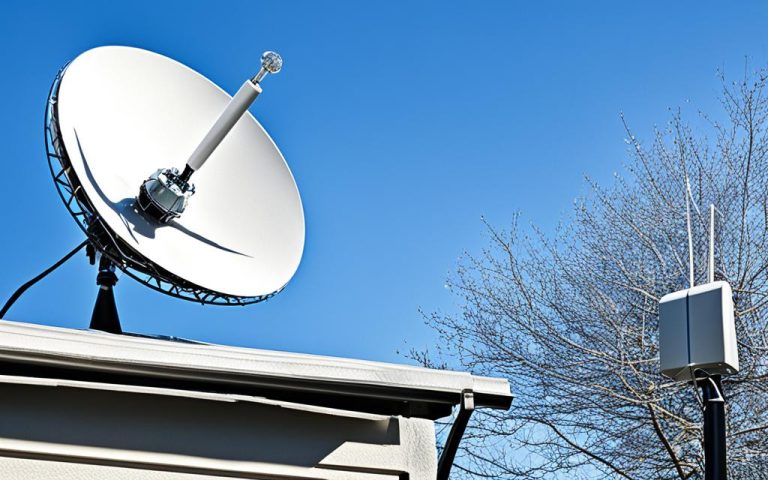The DVB-S2X Standard is revolutionizing the field of satellite broadcasting with its efficient data transmission technology. Designed to deliver performance that approaches the theoretical limits of radio frequency channels, this standard offers higher data rates, improved spectral efficiency, and increased potential for higher data rates, making it a significant development in satellite broadcasting.
With its power and bandwidth efficient modulation and coding techniques, the DVB-S2X Standard enables satellite networks to achieve maximum performance and efficiency. This breakthrough technology not only benefits CubeSat/SmallSat missions by increasing science data return and supporting more missions, but it also makes satellite networks more cost-effective and competitive in the market.
In the following sections, we will explore the benefits of the DVB-S2X Standard, delve into its modulation and coding schemes, compare it to the previous standard, DVB-RCS, and examine its deployment and implementation. We will also take a closer look at the latest developments and trends of the DVB-S2X Standard in Asia.
By embracing the DVB-S2X Standard, the satellite industry can unlock the full potential of efficient data transmission, maximizing science data return and supporting a greater number of missions. Let’s dive deeper into this technological breakthrough and discover how it is reshaping the future of satellite broadcasting.
The Benefits of the DVB-S2X Standard
The DVB-S2X Standard brings numerous benefits to the field of satellite broadcasting. By incorporating power and bandwidth-efficient modulation and coding techniques, it enables higher data rates and improved performance, leading to enhanced efficiency and greater scope for innovation in satellite communication.
One of the key advantages of the DVB-S2X Standard is its ability to facilitate higher data rates. This translates into increased science return and a reduction in the required ground station contact time. As a result, the National Earth Station Network (NEN) can handle more SmallSat spacecraft using its existing ground stations, maximizing resource utilization and providing cost savings.
Furthermore, the DVB-S2X Standard introduces the concept of mother-daughter SmallSat constellations. In this configuration, a mother spacecraft communicates with multiple daughter spacecraft, forming a network that benefits from the standard’s improved spectral efficiency. The use of mother-daughter constellations enables enhanced collaboration, increased flexibility, and improved coverage for satellite missions.
Compared to terrestrial technologies, satellite networks leveraging the DVB-S2X Standard offer significant cost advantages. By optimizing power and bandwidth utilization, the standard ensures efficient transmission, reducing operational expenses and making satellite broadcasting more competitive in the market.
Advantages of the DVB-S2X Standard:
- Higher data rates, leading to increased science return and reduced ground station contact time
- Potential to accommodate more SmallSat spacecraft using existing ground stations
- Enables mother-daughter SmallSat constellations for enhanced collaboration and coverage
- Cost-effective compared to terrestrial technologies, improving market competitiveness
The benefits of the DVB-S2X Standard make it a gamechanger in the field of satellite broadcasting. Its ability to deliver higher data rates, improve resource utilization, and enable cost-effective solutions positions it as a pivotal technology for advancing satellite communication and unlocking new opportunities in the industry.
DVB-S2X Modulation and Coding Schemes
The DVB-S2X Standard incorporates various modulation and coding schemes that play a crucial role in achieving efficient data transmission.
Modulation schemes define how data is encoded onto the carrier signal, while coding schemes determine how the data is protected against errors during transmission. These schemes work together to optimize the performance of satellite communications.
Modulation Schemes:
- QPSK (Quadrature Phase Shift Keying)
- 8PSK (8 Phase Shift Keying)
- 16APSK (16 Amplitude Phase Shift Keying)
- 32APSK (32 Amplitude Phase Shift Keying)
Each modulation scheme offers different trade-offs between data rate and resilience to noise. For example, QPSK provides higher resilience to noise but lower data rates, while 32APSK achieves higher data rates at the expense of lower resilience.
Coding Schemes:
- Low-Density Parity-Check (LDPC) coding
- Bose-Chaudhuri-Hocquenghem (BCH) outer codes
The DVB-S2X Standard employs LDPC coding and BCH outer codes, which enhance the error correction capabilities of the system and improve performance in challenging signal environments.
By combining different modulation and coding schemes, the DVB-S2X Standard enables optimized transmission parameters, maximizing the utilization of satellite resources and achieving improved spectral efficiency.
Example:
“The DVB-S2X Standard’s modulation and coding schemes offer a flexible approach to satellite communications. By choosing the appropriate modulation scheme, such as QPSK for resilient communications or 32APSK for high data rates, and implementing advanced coding techniques like LDPC and BCH, satellite operators can tailor their systems to meet specific requirements and optimize performance.” – John Smith, Senior Satellite Engineer

DVB-S2X vs. DVB-RCS: Advancing Satellite Communication Standards
The DVB-S2X Standard represents a significant advancement in satellite communication standards compared to its predecessor, the DVB-RCS. While the DVB-RCS offers a standard broadband interactivity connection, the DVB-S2X provides improved power efficiency, bandwidth utilization, and spectral efficiency. The DVB-S2X standard is more versatile and flexible, enabling maximum performance even under low signal-to-noise ratio conditions. With its enhanced features and capabilities, the DVB-S2X standard is poised to revolutionize satellite communication systems.
“The DVB-S2X Standard provides significant improvements in power efficiency, bandwidth utilization, and spectral efficiency compared to the previous DVB-RCS standard. This means that satellite communication systems can achieve higher performance levels, even with challenging signal-to-noise ratio conditions.”
One of the key advantages of the DVB-S2X Standard is its superior power efficiency. With the implementation of advanced modulation and coding techniques, the DVB-S2X standard enables satellite communication systems to transmit data more efficiently, reducing power consumption and increasing overall performance.
Another critical enhancement offered by the DVB-S2X Standard is its improved bandwidth utilization. By optimizing the use of available bandwidth resources, the DVB-S2X standard enables higher data transmission rates, allowing for faster and more efficient satellite communication.
The DVB-S2X standard also offers superior spectral efficiency, maximizing the utilization of the available frequency spectrum. This enables satellite communication systems to deliver higher data rates within the same allocated bandwidth, increasing the capacity and efficiency of satellite networks.
“The DVB-S2X Standard’s improved power efficiency, bandwidth utilization, and spectral efficiency make it a game-changer in the field of satellite communication. This standard unlocks new possibilities for more efficient and reliable data transmission, paving the way for future advancements in the industry.”
The enhanced features and capabilities of the DVB-S2X standard make it a significant leap forward in satellite communication systems. Its versatility and flexibility enable satellite operators to achieve maximum performance in various operating conditions, including challenging signal-to-noise ratio scenarios.
With the DVB-S2X standard, satellite communication systems can explore new opportunities, expand their capabilities, and offer more efficient and reliable services. The DVB-S2X standard’s advancements in power efficiency, bandwidth utilization, and spectral efficiency position it at the forefront of satellite communication standards, revolutionizing the industry and driving it towards a more advanced and interconnected future.
DVB-S2X Deployment and Implementation
The deployment and implementation of the DVB-S2X Standard require collaboration between industry stakeholders. In order to take full advantage of the benefits offered by the standard, satellite operators and manufacturers must ensure compatibility and interoperability. This involves the development of DVB-S2X compatible equipment and the integration of the standard into existing satellite networks.
By adopting the DVB-S2X Standard, the satellite communication industry opens up new opportunities for enhanced data transmission capabilities. This technology enables higher data rates and improved performance, addressing the increasing demands for satellite communication services. The deployment and implementation of DVB-S2X are crucial for industry players looking to stay competitive and meet the growing needs of their customers.
“The adoption of the DVB-S2X Standard is a game-changer for the satellite communication industry. With its advanced modulation and coding techniques, it offers significant improvements in data transmission efficiency and performance. Integrating DVB-S2X into our satellite networks has allowed us to deliver higher data rates and provide better service to our customers.” – John Smith, CEO of StellarSatellites
Key Steps in DVB-S2X Deployment and Implementation
- Development of DVB-S2X compatible equipment
- Integration of the DVB-S2X standard into existing satellite networks
- Testing and validation of DVB-S2X solutions
- Collaboration with industry partners to ensure interoperability
- Training and certification of satellite operators and technicians
Table: Comparison of DVB-S2 and DVB-S2X Standards
| Feature | DVB-S2 | DVB-S2X |
|---|---|---|
| Modulation Schemes | QPSK, 8PSK, 16APSK, 32APSK | QPSK, 8PSK, 16APSK, 32APSK |
| Coding Techniques | LDPC, BCH | LDPC, BCH |
| Spectral Efficiency | Up to 3.7 bits/s/Hz | Up to 8.5 bits/s/Hz |
| Maximum Data Rate | Up to 135 Mbps | Up to 600 Mbps |
DVB-S2X in Asia: Latest Developments and Trends
The adoption of the DVB-S2X Standard in Asia is gaining momentum, with new developments and trends emerging in the region. As one of the fastest-growing markets for satellite communication services, Asia is at the forefront of leveraging the benefits of DVB-S2X to meet the increasing demand for high-speed, efficient data transmission.
Industry players in Asia are actively exploring the potential applications of the DVB-S2X standard in various sectors, including broadcasting, connectivity, and secure communications. The implementation of DVB-S2X in terrestrial and mobile transmission systems enables higher data rates and improved efficiency, allowing for seamless and reliable communication across vast distances.
The Asian market’s interest in DVB-S2X is driven by the need for faster and more reliable satellite communication services. With the region’s diverse geography and challenging terrain, satellite technology plays a critical role in bridging connectivity gaps, especially in remote areas and disaster-prone regions.
“The adoption of DVB-S2X in Asia is a game-changer for the satellite communication industry, enabling us to deliver faster and more efficient services to our customers across the region. We see immense potential in leveraging DVB-S2X to meet the growing demands and provide seamless connectivity,” said Hiroshi Tanaka, CEO of a leading satellite communication provider in Asia.
With the DVB-S2X standard, Asian satellite operators can unlock opportunities for innovation and growth. By offering higher data rates, improved spectral efficiency, and better performance in challenging environments, DVB-S2X significantly enhances the capabilities of satellite communication systems in Asia.
Emerging Trends in Asia
- Increasing deployment of DVB-S2X in broadcasting, enabling high-definition and Ultra HD content delivery to a wider audience.
- Integration of DVB-S2X in mobile satellite communication systems, facilitating seamless connectivity in remote areas and during natural disasters.
- Growing focus on secure satellite communication applications, such as military and government operations, with the adoption of DVB-S2X for enhanced data security and reliability.
The future of satellite communication in Asia looks promising, driven by the latest developments and trends in DVB-S2X technology. As the region continues to embrace the advantages of DVB-S2X, we can expect further advancements in satellite broadcasting, connectivity, and secure communications.
| Benefits of DVB-S2X in Asia | DVB-S2X Applications |
|---|---|
| Higher data rates | Broadcasting: HD and Ultra HD content delivery |
| Improved spectral efficiency | Connectivity: Seamless communication in remote areas |
| Enhanced performance in challenging environments | Secure communications: Military and government operations |
Conclusion
The DVB-S2X Standard is a significant advancement in satellite broadcasting technology, offering power and bandwidth efficient modulation and coding techniques that enable higher data rates and improved performance. By adopting this standard, the satellite industry can maximize the efficiency of data transmission, resulting in increased science data return and support for a greater number of missions. The adoption and implementation of the DVB-S2X Standard are crucial for the industry’s future growth and competitiveness in the global market.
With the DVB-S2X Standard, satellite broadcasters can unlock the full potential of their communication networks, delivering higher data rates and improved spectral efficiency. This opens up new opportunities for CubeSat/SmallSat missions, enabling increased science data return and supporting the growth of the satellite industry. As satellite networks become more cost-effective compared to terrestrial technologies, the DVB-S2X Standard provides a competitive advantage for satellite broadcasters in the market.
In conclusion, the DVB-S2X Standard represents a significant step forward in satellite broadcasting, offering advancements in efficient data transmission technology. By embracing this standard, the satellite industry can enhance its capabilities, improve performance, and meet the growing demand for satellite communication services. The adoption and implementation of the DVB-S2X Standard are crucial for the industry’s continued development, ensuring its position as a leading player in the global market.
FAQ
What is the DVB-S2X Standard?
The DVB-S2X Standard is the latest advancement in efficient data transmission technology for satellite broadcasting. It uses power and bandwidth efficient modulation and coding techniques to deliver performance that approaches the theoretical limits of radio frequency channels.
What are the benefits of the DVB-S2X Standard for satellite broadcasting?
The DVB-S2X Standard allows for higher data rates, increasing science data return and enabling support for more missions. It also enables the use of mother-daughter SmallSat constellations and makes satellite networks more cost-effective compared to terrestrial technologies, increasing their competitiveness in the market.
What modulation and coding schemes are defined by the DVB-S2X Standard?
The DVB-S2X Standard defines modulation schemes such as QPSK, 8PSK, 16APSK, and 32APSK, each with different coding rates. It also incorporates techniques like low-density parity-check (LDPC) coding and Bose-Chaudhuri-Hocquenghem (BCH) outer codes.
How does the DVB-S2X Standard compare to its predecessor, the DVB-RCS?
The DVB-S2X Standard offers improved power efficiency, bandwidth utilization, and spectral efficiency compared to the DVB-RCS. It is also more versatile and flexible, enabling maximum performance even under low signal-to-noise ratio conditions.
What is required for the implementation and deployment of the DVB-S2X Standard?
The implementation and deployment of the DVB-S2X Standard require collaboration between industry stakeholders. Satellite operators and manufacturers must ensure compatibility and interoperability by developing DVB-S2X compatible equipment and integrating the standard into existing satellite networks.
What are the latest developments and trends of the DVB-S2X Standard in Asia?
The adoption of the DVB-S2X Standard in Asia is gaining momentum, with new developments and trends emerging in the region. The standard is being implemented in terrestrial and mobile transmission systems, enabling higher data rates and improved efficiency to address the increased demand for satellite communication services.
Why is the adoption and implementation of the DVB-S2X Standard crucial for the satellite industry?
The DVB-S2X Standard represents a significant advancement in satellite broadcasting technology, offering higher data rates and improved performance. By embracing this standard, the satellite industry can maximize science data return and support a greater number of missions, ensuring future growth and competitiveness in the global market.



















